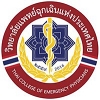The complications of basilar skull fracture in mild head injury patients
Keywords:
mild head injury, basilar skull fracture, complication, head CT scanAbstract
Introduction/Objective: Diagnosis of basilar skull fracture requires high resolution head computer tomography (CT) scan which takes up high costs and usually not available in most hospital. This study aim to find prevalence of intracranial hemorrhage and other complications in patient with basilar skull fracture from mild traumatic head injury to determine the need of head CT scan.
Methods: In a retrospective descriptive study, all patients age 15 years old or more who presented to emergency department with mild traumatic head injury and had signs of basilar skull fracture were enrolled. Diagnosis of basilar skull fracture was confirmed by head CT scan. We collected data from January, 2009 to September, 2012 to analyze and report complications of basilar skull fracture.
Results: Mild head injury patients who had basilar skull fracture confirmed by head CT scan and had symptoms of basilar skull fracture 65 cases were include in study. Complications were found in 61 patients (95.4%). Most complications were intracranial hemorrhage and cranial nerve compression which were found in 70.5% and 9.8% respectively. Among these patients, 12 (19.7%) were underwent cranial surgery. In patients who were performed head CT scan due to signs of basilar skull fracture, 70.3% of patients had complication. Signs of basilar skull fracture occurred in 58% of patients whom basilar skull fracture confirmed by head CT scan. The median length of hospital stay was 4 days.
Conclusion: Mild traumatic head injury patients who present with signs of basilar skull fracture has high rate of complication and considerable number of this group need surgical treatment. Therefore, head CT scan should be performed in all mild traumatic head injury patient who has any signs of basilar skull fracture.
References
Memduh Kerman BC, and Ahmet Dagtekin. Management of Skull Base Fractures. Neurosurgery Quarterly. 2002;12(1):23–41.
Kral T, Zentner J, Vieweg U, Solymosi L, Schramm J. Diagnosis and treatment of frontobasal skull fractures. Neurosurg Rev. 1997;20(1):19-23.
Patchell ETdlaRA. Classification and Management of Skull Base Fractures. Neurosurgery Quarterly 2002;12(1):42–62.
Villalobos T, Arango C, Kubilis P, Rathore M. Antibiotic prophylaxis after basilar skull fractures: a meta-analysis. Clin Infect Dis. 1998 Aug;27(2): 364-9.
Kapila A, Chakeres DW. Clivus fracture: CT demonstration. J Comput Assist Tomogr. 1985 Nov-Dec;9(6):1142-4.
Antoniades K, Karakasis D, Taskos N. Abducent nerve palsy following transverse fracture of the middle cranial fossa. J Craniomaxillofac Surg. 1993 Jun;21(4):172-5.
Dublin AB, Poirier VC. Fracture of the sella turcica. AJR Am J Roentgenol. 1976 Dec;127 (6):969-72.
Liang W, Xiaofeng Y, Weiguo L, Wusi Q, Gang S, Xuesheng Z. Traumatic carotid cavernous fistula accompanying basilar skull fracture: a study on the incidence of traumatic carotid cavernous fistula in the patients with basilar skull fracture and the prognostic analysis about traumatic carotid cavernous fistula. J Trauma. 2007 Nov; 63(5):1014-20; discussion 20.
Worthington JP, Snape L. Horner's syndrome secondary to a basilar skull fracture after maxillofacial trauma. J Oral Maxillofac Surg. 1998 Aug;56(8):996-1000.
Borthne A, Sortland O, Blikra G. [Head injuries with delayed intracranial hemorrhage].Tidsskr Nor Laegeforen. 1992 Nov 10;112(27):3425-8
Soloniuk D, Pitts LH, Lovely M, Bartkowski H. Traumatic intracerebral hematomas: timing of appearance and indications for operative removal. J Trauma. 1986 Sep;26(9):787-94.
Brodie HA, Thompson TC. Management of complications from 820 temporal bone fractures. Am J Otol. 1997 Mar;18(2):188-97.
Kadish HA, Schunk JE. Pediatric basilar skull fracture: do children with normal neurologic findings and no intracranial injury require hospitalization? Ann Emerg Med. 1995 Jul;26(1): 37-41.
Institute T. Clinical practice guildlines in surgery. Royal College of Surgeons of Thailand 2008.
VAN BAALEN B. OE, MAAS A. I. R., 2002 - Traumatic Brain Injury: Severity and Outcome. In: L. VJ, editor. 2002 Yearbook of Intensive Care and Emergency Medicine. Berlin: Springer.
Mena JH, Sanchez AI, Rubiano AM, Peitzman AB, Sperry JL, Gutierrez MI, et al. Effect of the modified Glasgow Coma Scale score criteria for mild traumatic brain injury on mortality prediction: comparing classic and modified Glasgow Coma Scale score model scores of 13. J Trauma. 2011 Nov;71(5):1185-92; discussion 93.
Servadei F, Teasdale G, Merry G. Defining acute mild head injury in adults: a proposal based on prognostic factors, diagnosis, and management. J Neurotrauma. 2001 Jul;18(7):657-64.
Resnick DK, Subach BR, Marion DW. The significance of carotid canal involvement in basilar cranial fracture. Neurosurgery. 1997 Jun;40(6):1177-81.
Eftekhar B, Ghodsi M, Nejat F, Ketabchi E, Esmaeeli B. Prophylactic administration of ceftriaxone for the prevention of meningitis after traumatic pneumocephalus: results of a clinical trial. J Neurosurg. 2004 Nov;101(5):757-61
Pretto Flores L, De Almeida CS, Casulari LA. Positive predictive values of selected clinical Signs associated with skull base fractures. J Neurosurg Sci. 2000 Jun;44(2):77-82; discussion -3.
Surgeons ACo. Advanced trauma life support. 8th ed. America 2008.
Stiell IG, Wells GA, Vandemheen K, Clement C, Lesiuk H, Laupacis A, et al. The Canadian CT Head Rule for patients with minor head injury. Lancet. 2001 May 5;357(9266):1391-6
Downloads
Published
How to Cite
License
บทความที่ได้รับตีพิมพ์ในวารสารเวชศาสตร์ฉุกเฉินแห่งประเทศไทย ถือเป็นเป็นลิขสิทธิ์ของ วิทยาลัยแพทย์เวชศาสตร์ฉุกเฉินแห่งประเทศไทย
กรณีที่บทความได้รับการตีพิมพ์ในวารสารเวชศาสตร์ฉุกเฉินแห่งประเทศไทยแล้ว จะตีพิมพ์ในรูปแบบอิเล็กทรอนิกส์ ไม่มีสำเนาการพิมพ์ภายหลังหนังสือเผยแพร่เรียบร้อยแล้ว ผู้นิพนธ์ไม่สามารถนำบทความดังกล่าวไปนำเสนอหรือตีพิมพ์ในรูปแบบใดๆ ที่อื่นได้ หากมิได้รับคำอนุญาตจากวารสารเวชศาสตร์ฉุกเฉินแห่งประเทศไทย




